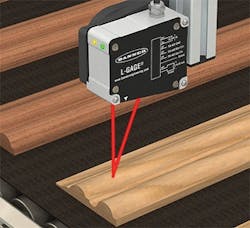Measuring Distance With Laser Sensor Technology
Manufacturing inspection applications that once required simple presence and absence detection of an object now ask sensors to solve demanding measurement and quality control tasks. Obtaining accurate and stable measurements is crucial to ensure consistent product quality and continuous production.
Laser sensor technology can solve these inspection applications with high-speed, high-precision performance. It can be used on multiple materials, reflective surfaces and colors, allowing manufacturers to collect continuous measurements in a range of industries, including applications with moving processes, stamped or machine parts, and soft or sticky parts.
Advanced laser sensors comprise a rugged, self-contained housing, a pinpoint laser emitter, a linear imager and user configurable outputs. Laser sensors require no external controller for adjustments. Operators can simply place the laser sensor in any location—including inaccessible areas of the machine or harsh environments—and make all necessary adjustments and configurations through various software tools.
Source: Banner Engineering
Automatic laser power and measurement rate control ensure reliable measurement under changing or challenging target conditions.
Linear Imagers
The linear imager is one of the primary components of a modern-day laser distance sensor, defined as the eye of the sensor, and is made of hundreds or thousands of pixels arranged in a line. Some advanced laser sensors operate based on the principle of optical triangulation, which incorporates the linear imager. The linear image is used to detect precisely where the target is in front of the sensor—ultimately resulting in an accurate, stable measurement. A laser emitter transmits visible laser light through a lens, towards a target or object. The laser light is reflected diffusely from the surface of the target, where a receiver lens on the sensor then focuses that reflected light, creating a spot of light on the linear imager.
The target's distance from the sensor determines the angle the light travels through the receiver lens; this angle then determines where the received light will hit the linear imager. If the target is far away (at the maximum specified range), then the light will fall toward the end of the imager closest to the laser emitter. Alternatively, if the target is at its closest position (at the minimum specified range), then the light will land at the opposite end of the imager farthest away from the laser emitter. The position of the light on the linear imager is calibrated in the factory for all valid target distances. The received light is processed through analog and digital electronics and analyzed by the digital signal processor (DSP), which determines the distance to the current target relative to the start of the measurement range very precisely by calculating the location of the received light on the linear imager and updating the sensor output to indicate the correct target distance.
Read more of this article: http://www.bannerengineering.com/en-US/ljyhs
About the Author
Banner Engineering
Banner Engineering

Leaders relevant to this article:

